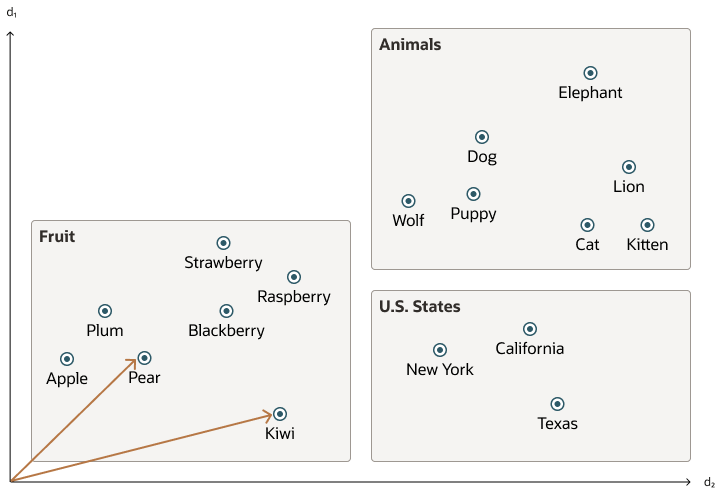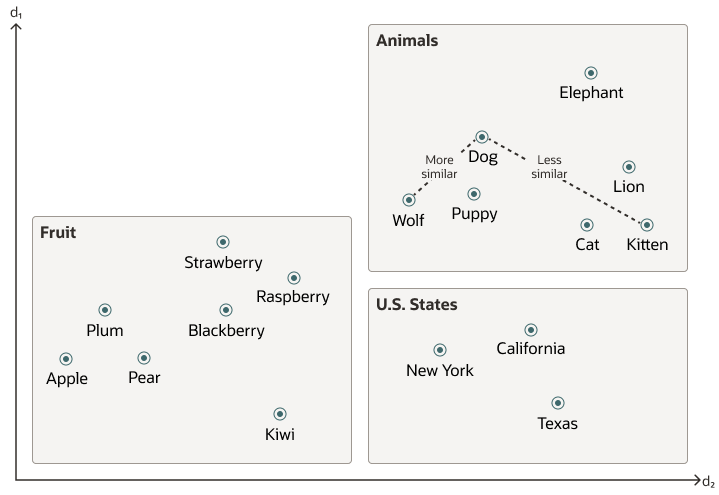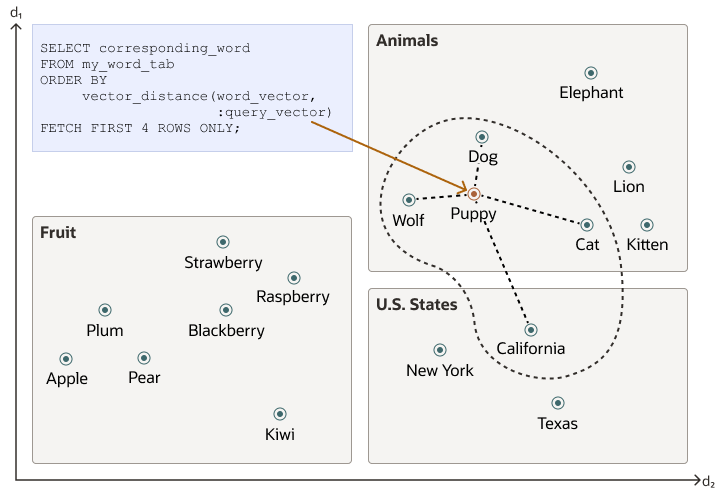Overview of Oracle AI Vector Search
Oracle AI Vector Search is designed for Artificial Intelligence (AI) workloads and allows you to query data based on semantics, rather than keywords.
VECTOR Data Type
The VECTOR data type is introduced with the release of
Oracle AI Database 26ai, providing the foundation to store vector embeddings
alongside business data in the database. Using embedding models, you can transform
unstructured data into vector embeddings that can then be used for semantic queries
on business data. In order to use the VECTOR data type and its
related features, the COMPATIBLE initialization parameter must be
set to 23.4.0 or higher. For more information about the parameter and how to change
it, see Oracle AI Database Upgrade
Guide.
See the following basic example of using the VECTOR data type in a
table definition:
CREATE TABLE docs (doc_id INT, doc_text CLOB, doc_vector VECTOR);For more information about the VECTOR data type and how
to use vectors in tables, see Create Tables Using the VECTOR Data
Type.
VECTOR data type, you
can use it as an input to the machine learning algorithms such as classification,
anomaly, regression, clustering and feature extraction. More details on using
VECTOR data type in machine learning could be found in Vector Data Type Support.
Note:
Support forVECTOR data type machine learning is available in all
versions starting with 23.7.
Vector Embeddings
If you've ever used applications such as voice assistants, chatbots, language translators, recommendation systems, anomaly detection, or video search and recognition, you've implicitly used vector embeddings features.
Oracle AI Vector Search stores vector embeddings, which are mathematical vector representations of data points. These vector embeddings describe the semantic meaning behind content such as words, documents, audio tracks, or images. As an example, while doing text based searches, vector search is often considered better than keyword search as vector search is based on the meaning and context behind the words and not the actual words themselves. This vector representation translates semantic similarity of objects, as perceived by humans, into proximity in a mathematical vector space. This vector space usually has many hundreds, if not thousands, of dimensions. Put differently, vector embeddings are a way of representing almost any kind of data, such as text, images, videos, users, or music as points in a multidimensional space where the locations of those points in space, and proximity to others, are semantically meaningful.
This simplified diagram illustrates a vector space where words are encoded as 2-dimensional vectors.
Similarity Search
Searching semantic similarity in a data set is now equivalent to searching nearest neighbors in a vector space instead of using traditional keyword searches using query predicates. As illustrated in the following diagram, the distance between dog and wolf in this vector space is shorter than the distance between dog and kitten. In this space, a dog is more similar to a wolf than it is to a kitten. See Perform Exact Similarity Search for more information.
Vector data tends to be unevenly distributed and clustered into groups that are semantically related. Doing a similarity search based on a given query vector is equivalent to retrieving the K-nearest vectors to your query vector in your vector space. Basically, you need to find an ordered list of vectors by ranking them, where the first row in the list is the closest or most similar vector to the query vector, the second row in the list is the second closest vector to the query vector, and so on. When doing a similarity search, the relative order of distances is what really matters rather than the actual distance.
Using the preceding vector space, here is an illustration of a semantic search where your query vector is the one corresponding to the word Puppy and you want to identify the four closest words:
Similarity searches tend to get data from one or more clusters depending on the value of the query vector and the fetch size.
Approximate searches using vector indexes can limit the searches to specific clusters, whereas exact searches visit vectors across all clusters. See Use Vector Indexes for more information.
Vector Embedding Models
One way of creating such vector embeddings could be to use someone's domain expertise to quantify a predefined set of features or dimensions such as shape, texture, color, sentiment, and many others, depending on the object type with which you're dealing. However, the efficiency of this method depends on the use case and is not always cost effective.
Instead, vector embeddings are created via neural networks. Most modern vector embeddings use a transformer model, as illustrated by the following diagram, but convolutional neural networks can also be used.
Depending on the type of your data, you can use different pretrained, open-source models to create vector embeddings. For example:
- For textual data, sentence transformers transform words, sentences, or paragraphs into vector embeddings.
- For visual data, you can use Residual Network (ResNet) to generate vector embeddings.
- For audio data, you can use the visual spectrogram representation of the audio data to fall back into the visual data case.
Each model also determines the number of dimensions for your vectors. For example:
- Cohere's embedding model embed-english-v3.0 has 1024 dimensions.
- OpenAI's embedding model text-embedding-3-large has 3072 dimensions.
- Hugging Face's embedding model all-MiniLM-L6-v2 has 384 dimensions
Of course, you can always create your own model that is trained with your own data set.
Import Embedding Models into Oracle AI Database
Although you can generate vector embeddings outside the Oracle AI Database using pretrained open-source embeddings models or your own embeddings models, you also have the option to import those models directly into the Oracle AI Database if they are compatible with the Open Neural Network Exchange (ONNX) standard. Oracle AI Database implements an ONNX runtime directly within the database. This allows you to generate vector embeddings directly within the Oracle AI Database using SQL. See Generate Vector Embeddings for more information.
Parent topic: Overview



